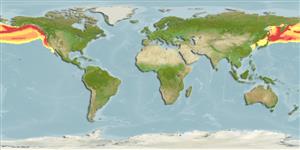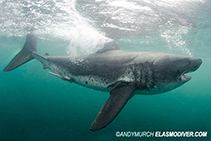Waarneming toevoegen in Fish Watcher
| Native range |

|
| This map was computer-generated and has not yet been reviewed. |
| Lamna ditropis AquaMaps Data sources: GBIF OBIS |
Uploaden van uw Foto's en video's
Pictures | Google afbeeldingLamna ditropis
Afbeelding van Murch, A.
Pictures | Google afbeeldingLamna ditropis
Afbeelding van Murch, A.
Classificatie / Names Lokale namen | Synoniemen | Catalog of Fishes(Genus, Soort(en)) | ITIS | CoL | WoRMS | Cloffa
Elasmobranchii (haaien en roggen) (sharks and rays) > Lamniformes (Mackerel sharks) > Lamnidae (Mackerel sharks or white shark)
Etymology: Lamna: From the Greek lamia, a large and voracious shark, originally from Lamia in Greek mythology, daughter of King Belos, who revenged the murder of her children by killing the children of others, and who behaved so cruelly that her face turned into a nightmarish mask (See ETYFish); ditropis: di-, from dis (L.), in two; tropis (Gr.), keel, i.e., double-keeled, referring to the rudder-like projections on either side of tail (See ETYFish).
Eponymy: The genus name comes from the Greek lamia, a large and voracious shark. [...] (Ref. 128868), visit book page.
More on authors: Hubbs & Follett.
Etymology: Lamna: From the Greek lamia, a large and voracious shark, originally from Lamia in Greek mythology, daughter of King Belos, who revenged the murder of her children by killing the children of others, and who behaved so cruelly that her face turned into a nightmarish mask (See ETYFish); ditropis: di-, from dis (L.), in two; tropis (Gr.), keel, i.e., double-keeled, referring to the rudder-like projections on either side of tail (See ETYFish).
Eponymy: The genus name comes from the Greek lamia, a large and voracious shark. [...] (Ref. 128868), visit book page.
More on authors: Hubbs & Follett.
Environment: milieu / climate zone / depth range / distribution range Ecologie
marien pelagic-oceanic; oceanodroom (Ref. 51243); diepte 0 - 650 m (Ref. 50550), usually 0 - 152 m (Ref. 55221). Boreal; 66°N - 22°N, 120°E - 115°W
Verspreiding Landen | FAO regio's | Ecosystemen | Voorkomen | Point map | Introducties | Faunafri
North Pacific: Japan, Korea, and the Sea of Okhotsk to the Bering Sea and southward to southern California, USA (Ref. 247) and Baja California, Mexico (Ref. 9253).
Lengte bij maturiteit / Grootte / Gewicht / Leeftijd
Maturity: Lm ? range ? - 221 cm
Max length : 305 cm TL mannelijk / geslacht onbekend; (Ref. 247); common length : 180 cm TL mannelijk / geslacht onbekend; (Ref. 9988); max. gepubliceerd gewicht: 175.0 kg (Ref. 9988); max. gerapporteerde leeftijd: 27 Jaren (Ref. 119696)
Max length : 305 cm TL mannelijk / geslacht onbekend; (Ref. 247); common length : 180 cm TL mannelijk / geslacht onbekend; (Ref. 9988); max. gepubliceerd gewicht: 175.0 kg (Ref. 9988); max. gerapporteerde leeftijd: 27 Jaren (Ref. 119696)
Korte beschrijving Determinatiesleutels | Morfologie | Morfometrie
Dorsale stekels (totaal) : 0; Anale stekels: 0. First dorsal fin uniformly dark, no light rear tip; ventral surface of body white with dusky blotches (Ref. 247).
Body shape (shape guide): fusiform / normal.
Body shape (shape guide): fusiform / normal.
A coastal-littoral and epipelagic shark that prefers boreal to cool temperate waters, from the surface to at least 152 m, and is common in continental offshore waters but range inshore to just off beaches. Occurs singly or in schools or feeding aggregations of several individuals; feeds on fishes (Ref. 247). Seasonally migratory (following food prey) and segregate by age and sex where adults move further north than young (Ref. 58085). Ovoviviparous, embryos feeding on yolk sac and other ova produced by the mother (Ref. 50449). With up to 4 young in a litter (Ref. 247). Fast swimmer (Ref. 9988). Potentially dangerous but has never or seldom been implicated in human attacks (Ref. 247). Causes considerable damage to commercial catches and gear (Ref. 6885). Utilized fresh, dried or salted, and frozen; fins, hides and livers are also used, with fins having particular value; can be broiled and baked (Ref. 9988). Reported to attain at least 27 years of age and reach maximum depth of at least 792 m (in Ref. 119696).
Levenscyclus en paargedrag Maturiteit | Voortplanting | Paaien | Eieren | Fecunditeit | Larven
Exhibit ovoviparity (aplacental viviparity), with embryos feeding on other ova produced by the mother (oophagy) after the yolk sac is absorbed (Ref. 50449). Litter size is up to 4 young (Ref. 247). Distinct pairing with embrace (Ref. 205).
Hoofdreferentie
Upload your references | Referenties | Coördinator : Compagno, Leonard J.V. | Medewerkers
Compagno, L.J.V., 1984. FAO Species Catalogue. Vol. 4. Sharks of the world. An annotated and illustrated catalogue of shark species known to date. Part 1 - Hexanchiformes to Lamniformes. FAO Fish. Synop. 125(4/1):1-249. Rome, FAO. (Ref. 247)
Status op de Rode Lijst van het IUCN (Ref. 130435: Version 2024-2)
Niet bedreigd (LC) ; Date assessed: 06 November 2018
CITES
Not Evaluated
Gevaar voor de mens
Traumatogenic
Gebruik door de mens
Visserij: van minder commercieel belang; sportvis: ja
FAO - visserij: soortsprofiel; Publication: search | FishSource |
Meer informatie
Population dynamics
Groeiparameters
Max. ages / sizes
Length-weight rel.
Length-length rel.
Lengtefrequenties
Massaconversie
Rekrutering
Abundantie
Groeiparameters
Max. ages / sizes
Length-weight rel.
Length-length rel.
Lengtefrequenties
Massaconversie
Rekrutering
Abundantie
Life cycle
Voortplanting
Maturiteit
Maturity/Gills rel.
Fecunditeit
Paaien
Spawning aggregations
Eieren
Ontwikkeling van de eieren
Larven
Larvale populatiedynamiek
Voortplanting
Maturiteit
Maturity/Gills rel.
Fecunditeit
Paaien
Spawning aggregations
Eieren
Ontwikkeling van de eieren
Larven
Larvale populatiedynamiek
Anatomy
Kieuwoppervlak
Brain
Otolith
Kieuwoppervlak
Brain
Otolith
Physiology
Body composition
Nutrients
Zuurstofverbruik
Zwemtype
Zwemsnelheid
Visual pigments
Fish sound
Diseases & Parasites
Toxicity (LC50s)
Body composition
Nutrients
Zuurstofverbruik
Zwemtype
Zwemsnelheid
Visual pigments
Fish sound
Diseases & Parasites
Toxicity (LC50s)
Genetics
Genetica
Heterozygosity
Erfelijkheid
Genetica
Heterozygosity
Erfelijkheid
Human related
Aquaculture systems
Aquacultuurprofielen
Kweeklijnen
Ciguatera cases
Stamps, coins, misc.
Aquaculture systems
Aquacultuurprofielen
Kweeklijnen
Ciguatera cases
Stamps, coins, misc.
Tools
E-boek | Veldgids | Determinatiesleutels | Lengtefrequentie Tool | Levenscyclus tool | Verspreidingskaart | Classification Tree
| Catch-MSY |
Speciale rapporten
Bekijk gegevens voor het houden in een aquarium | Bekijk Fact Sheets voor de soort | Bekijk Aquacultuur Fact Sheets
Download XML
Internetbronnen
AFORO (otoliths) | Aquatic Commons | BHL | Cloffa | BOLDSystems | Websites from users | Bekijk FishWatcher | CISTI | Catalog of Fishes: Genus, Soort(en) | DiscoverLife | ECOTOX | FAO - visserij: soortsprofiel; Publication: search | Faunafri | Fishipedia | Fishtrace | GenBank: genoom, nucleotide | GloBI | Google Books | Google Scholar | Google | IGFA World Record | MitoFish | Otolith Atlas of Taiwan Fishes | PubMed | Reef Life Survey | Socotra Atlas | Tree of Life | Wikipedia: ga naar, zoek | World Records Freshwater Fishing | Zoobank | Zoological Record
Estimates based on models
Preferred temperature (Ref. 123201): 1.7 - 8.7, mean 4.7 °C (based on 832 cells).
Fylogenetische diversiteitsindex (Ref. 82804): PD50 = 0.7813 [Uniqueness, from 0.5 = low to 2.0 = high].
Bayesian length-weight: a=0.00933 (0.00409 - 0.02131), b=3.04 (2.85 - 3.23), in cm total length, based on LWR estimates for this (Sub)family-body shape (Ref. 93245).
Trofisch niveau (Ref. 69278): 4.5 ±0.80 se; based on food items.
Generation time: 6.5 ( na - na) years. Estimated as median ln(3)/K based on 2 growth studies.
Weerstandsvermogen (Ref. 120179): Zeer laag, minimale populatieverdubbelingstijd meer dan 14 jaar (Fec=4).
Fishing Vulnerability (Ref. 59153): High vulnerability (59 of 100).
Nutrients (Ref. 124155): Calcium = 3.95 [1.03, 23.07] mg/100g; Iron = 0.366 [0.089, 1.235] mg/100g; Protein = 19.5 [17.2, 22.0] %; Omega3 = 0.396 [0.154, 1.000] g/100g; Selenium = 14.3 [3.8, 43.3] μg/100g; VitaminA = 5.42 [1.11, 26.30] μg/100g; Zinc = 0.185 [0.091, 0.353] mg/100g (wet weight);




